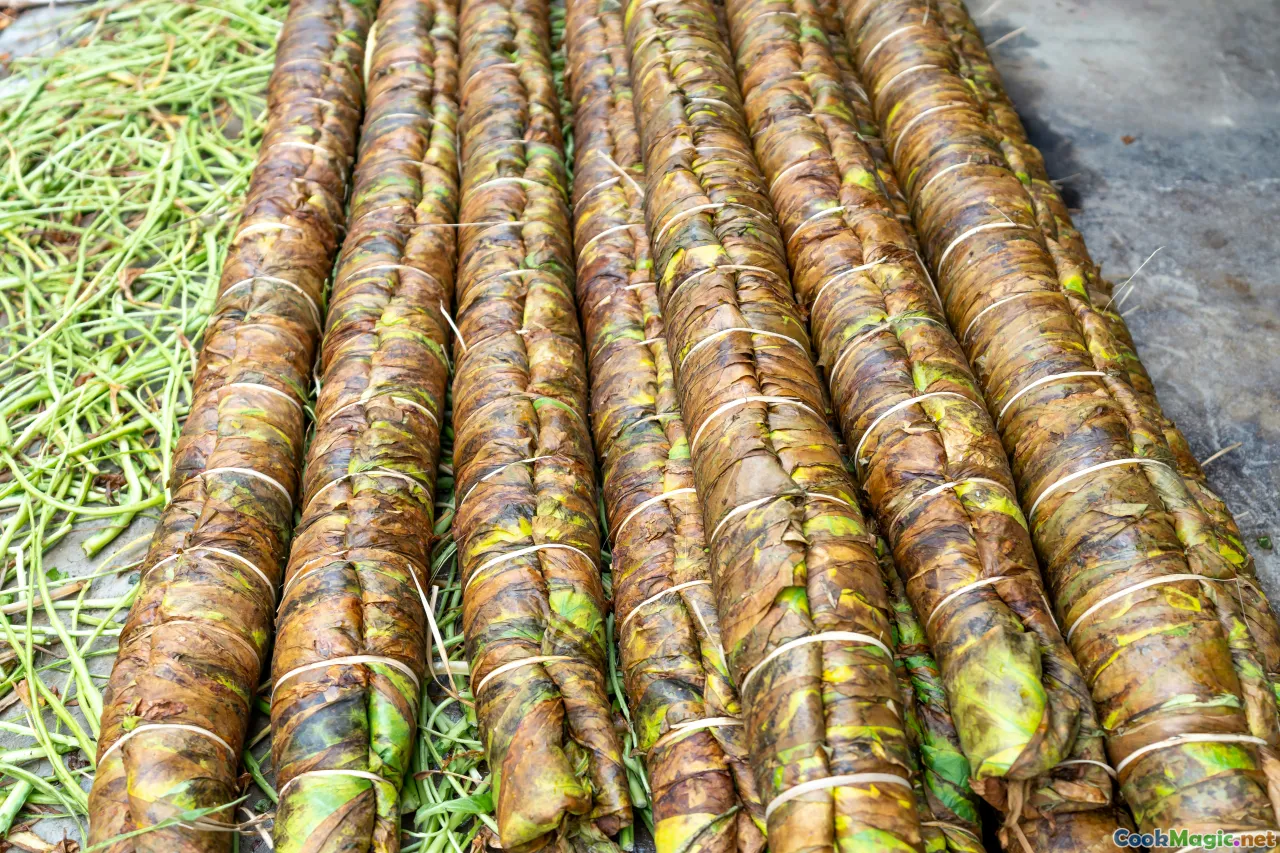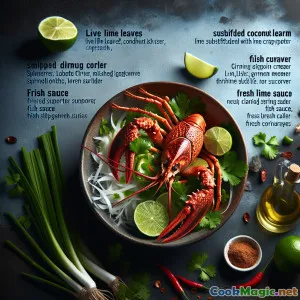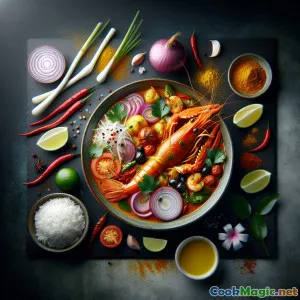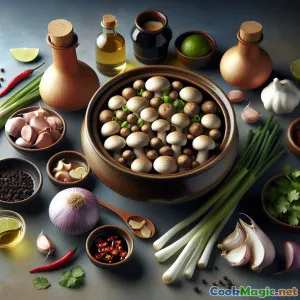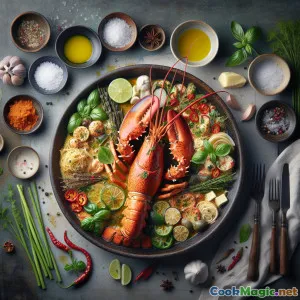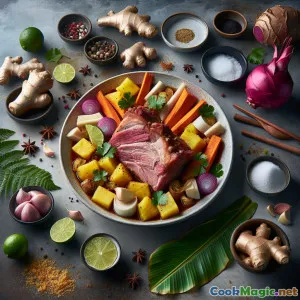
Ofengebackenes Schweinefleisch mit Papua-Neuguinea-Geschmack
(Pit Baked Pork with Papua New Guinea Flavors)
(0 Bewertungen)0
1,103
Juli 19, 2025
Problem melden
Zutaten
-
2 kg Schweineschulter mit Knochen
(Pariert, idealerweise Freilandhaltung)
-
500 grams Süßkartoffeln
(In Würfel geschnitten)
-
350 grams Taro-Wurzel
(Geschält und gehackt)
-
1 medium Ananas
(Entkernt und gewürfelt.)
-
6 whole Limettenblätter
(Frisch oder gefroren)
-
5 cm Ingwer
(Frisch, gerieben)
-
6 whole Knoblauchzehen
(Zerdrückt)
-
200 ml Kokoscreme
(Vor dem Gebrauch gut schütteln)
-
2 tbsp Kashersalz
-
1 tbsp Schwarzer Pfeffer
(Frisch gemahlen)
-
4 large sheets Bananenblätter
(Die Grube oder das Backblech auslegen.)
-
1 bunch Frischer Koriander
(Grob gehackt, zum Garnieren)
-
1 tbsp Zuckerrohrzucker
(Für eine subtile Süße)
-
2 whole Zitronengrasstängel
(Zerschlagen)
(Pariert, idealerweise Freilandhaltung)
(In Würfel geschnitten)
(Geschält und gehackt)
(Entkernt und gewürfelt.)
(Frisch oder gefroren)
(Frisch, gerieben)
(Zerdrückt)
(Vor dem Gebrauch gut schütteln)
(Frisch gemahlen)
(Die Grube oder das Backblech auslegen.)
(Grob gehackt, zum Garnieren)
(Für eine subtile Süße)
(Zerschlagen)
Nährwerte
- Portionen: 6
- Portionsgröße: 1 herzhafte Portion (300 g)
- Calories: 630 kcal
- Carbohydrates: 48 g
- Protein: 36 g
- Fat: 32 g
- Fiber: 7 g
- Sugar: 14 g
- Sodium: 1120 mg
- Cholesterol: 110 mg
- Calcium: 92 mg
- Iron: 3.1 mg
Anweisungen
-
1 - Bereite die Grube (oder den Ofen) vor:
Wenn eine traditionelle Grube machbar ist, grabe ein Loch von etwa 600 mm Tiefe, lege es mit Flusssteinen aus und entzünde ein Holzfeuer. Erwärme die Steine eine Stunde. Andernfalls heize den Ofen auf 180 °C (356 °F) vor und lege ein großes Backblech mit Bananenblättern aus.
-
2 - Das Schweinefleisch marinieren:
In einer großen Schüssel mischen Sie Ingwer, Knoblauch, Kokoscreme, Salz, schwarzen Pfeffer, Limettenblätter, Zuckerrohrzucker (optional) und Zitronengras. Reiben Sie die Mischung gut in das Schweinefleisch ein. Lassen Sie es 20-30 Minuten ruhen.
-
3 - Schichten anordnen:
Auf Bananenblättern schichten Sie Taro, Süßkartoffeln und Ananaswürfel. Legen Sie darauf das marinierte Schweinefleisch und verstreuen Sie die restliche Marinade sowie die Reste der Bananenblätter darum herum.
-
4 - Backfolie zum Backen:
Falten Sie die Bananenblätter fest um die Zutaten. Befestigen Sie sie mit Schnur oder Zweigen; verwenden Sie bei Bedarf zusätzliche Folie, wenn Sie den Ofen benutzen.
-
5 - In der Erde vergraben und backen:
In der Grube: Legen Sie das Bündel auf heiße Steine, bedecken Sie es großzügig mit Erde und heißen Steinen für 4 Stunden. Im Ofen: Abgedeckt 3-4 Stunden rösten. Zur Hälfte wenden für gleichmäßiges Garen.
-
6 - Finaler Tipp & Anrichten:
Entfalte die Bananenblätter, prüfe die Zartheit des Schweinefleischs (es sollte gabelzart sein). Schneide das Schweinefleisch in Scheiben, serviere es auf Gemüse und garniere mit frischem Koriander.
Wenn eine traditionelle Grube machbar ist, grabe ein Loch von etwa 600 mm Tiefe, lege es mit Flusssteinen aus und entzünde ein Holzfeuer. Erwärme die Steine eine Stunde. Andernfalls heize den Ofen auf 180 °C (356 °F) vor und lege ein großes Backblech mit Bananenblättern aus.
In einer großen Schüssel mischen Sie Ingwer, Knoblauch, Kokoscreme, Salz, schwarzen Pfeffer, Limettenblätter, Zuckerrohrzucker (optional) und Zitronengras. Reiben Sie die Mischung gut in das Schweinefleisch ein. Lassen Sie es 20-30 Minuten ruhen.
Auf Bananenblättern schichten Sie Taro, Süßkartoffeln und Ananaswürfel. Legen Sie darauf das marinierte Schweinefleisch und verstreuen Sie die restliche Marinade sowie die Reste der Bananenblätter darum herum.
Falten Sie die Bananenblätter fest um die Zutaten. Befestigen Sie sie mit Schnur oder Zweigen; verwenden Sie bei Bedarf zusätzliche Folie, wenn Sie den Ofen benutzen.
In der Grube: Legen Sie das Bündel auf heiße Steine, bedecken Sie es großzügig mit Erde und heißen Steinen für 4 Stunden. Im Ofen: Abgedeckt 3-4 Stunden rösten. Zur Hälfte wenden für gleichmäßiges Garen.
Entfalte die Bananenblätter, prüfe die Zartheit des Schweinefleischs (es sollte gabelzart sein). Schneide das Schweinefleisch in Scheiben, serviere es auf Gemüse und garniere mit frischem Koriander.
Mehr über: Ofengebackenes Schweinefleisch mit Papua-Neuguinea-Geschmack
Mount Hagen Pit Baked Pork
Mount Hagen Pit Baked Pork is a culinary homage to the Earth oven (“mumu”) feasts deeply woven into Papua New Guinean highland life. Named after Mount Hagen—a fertile region humming with life, culture, and traditions—this impressive pork dish epitomizes communal feasting, respect for nature’s bounty, and indigenous inventiveness. Traditionally crafted for grand gatherings, the mumu not only cooks but transforms—the pork imbibes aromatic herbs and earthy essence through hours of gentle, pit-based steam-baking.
Origin & Cultural Significance
The concept of baking meat and tubers in earth pits predates written history and is celebrated throughout Oceania, including Hawaii’s ʻimu, New Zealand’s Māori hāngi, or the samurai earthen ovens of Japan. In Papua New Guinea, the mumu—named for the fashioning of hot stone-lined pits, layered with banana leaves—stands as a gastronomic and social centerpiece. Every aspect—stone selection, ingredient choice, fire and assembly order—is ceremonial, meant to foster kinship and celebrate shared bounty.
Mount Hagen, with its rolling, alluvial highlands, supplies earthy sweet potatoes (“kaukau”), starchy taros, and a whole spectrum of local greens, roots, and fruits. Pork remains especially prized, a marker of status and festivity—as well as economic wealth. Roasting it in a pit unleashes depths of flavor unattainable through modern means: fragrant steam perfumes flesh and vegetables while natural sugars caramelize against the hot stones.
Key Ingredients & Substitutions
The backbone of the dish is well-marbled pork shoulder or leg, marinated with an island blend of ginger, garlic, lime leaves, coconut cream, and hints of sugar cane. Locally, everything from ferns (“pitpit”) to wild greens and pandanus fruit may be included. When fresh banana leaves aren’t available, parchment paper and foil offer an urban compromise, though they cannot replicate the subtlety of roasted leaf aroma.
Fresh sweet potatoes and taro, both integral to the highland pantry, provide satisfying ballast and soak up pork drippings. Pineapple lends sweet acidity—a nod to the tropics’ abundant harvest. Coriander and lemongrass bring a freshness that cuts richness and aligns with regional flavor profiles. While pit-cooking imparts incomparable smokiness, an oven executed skillfully still delivers meltingly tender pork, steeped in savory-sweet juices.
Techniques, Tips & Notes
- If using a pit: Safety first—enlist help, be wary of hot stone placement, and tightly wrap that banana-leaf bundle!
- Oven method: Use ample banana leaves and double-wrap in foil to retain moisture before slow-roasting.
- Marinate as long as possible. At least 30 minutes infuses flavor but overnight is even better.
- Experiment: Slices of plantain, yams, or cassava give alternate root flavors. Spice the marinade with native bush pepper or hot chili if you wish.
- Smashing lemongrass stalks bruises their essential oils—don’t skip this step if you want citrusy undertones.
- Allow to rest post-baking before opening the parcel; this reabsorbs juices and ensures maximum savor.
History and Uniqueness
Mount Hagen itself hosts the famed cultural show—a gathering of tourists, tribes, and locals fiercely proud of their gastronomy. A ``pit baked pork'' centerpiece symbolizes hospitality, tradition, and ceremony. Visitors and home cooks alike are drawn to its harmony: lush vegetables, tropical fruits, the primal simplicity of fire, earth, and time fusing into nourishment.
With this recipe, urban kitchens can channel ancestral crafts while tucking into fork-tender pork, caramel-kissed vegetables, and savoring the magic born where nature, culture, and food converge. For the adventurous foodie, few dishes encapsulate such depth of place or purpose. Invite friends, cook together, play highland music, and serve with a side of warm storytelling—the essence of the Papua New Guinea mumu feast.
Personal thoughts: The Mount Hagen Pit Baked Pork is more than just a recipe—it’s an experience; a delicious taste of community, ceremony, and respect for the earth’s providence. Perfect for celebration, Sunday feasts, or any meal where food becomes a story.


